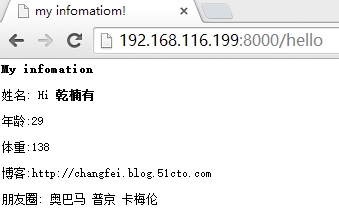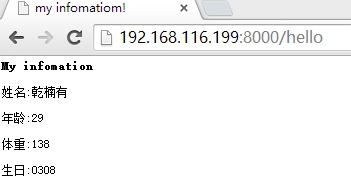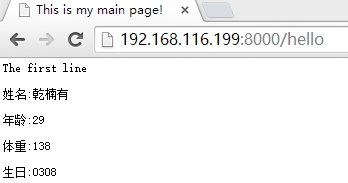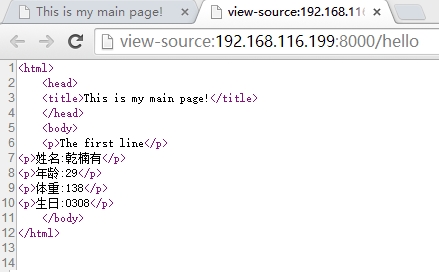內嵌語句
只要在``.``.``.`` 中的Python 語句返回一個字符串或有一個字符串的表達形式,它就是一個有效的語句。
>>>from bottle import template
>>>template('hello `name`', name='ju')
u'helloju'
>>>template('hello {{name if name else "world!"}}', name=None)
u'helloworld!'
>>>template('hello {{name if name else "world!"}}',name="feige")
u'hellofeige'{{}} 中的Python 語句會在渲染的時候被執行,可訪問傳遞給SimpleTemplate.render()方法的所有參數。默認情況下,自動轉義HTML 標籤以防止XSS ***。可在語句前加上”!”來關閉自動轉義。
>>>template('hello {{name if name else "world!"}}',name="<b>feige</b>")
u'hello<b>feige</b>'
>>>template('hello {{!name if name else "world!"}}',name="<b>feige</b>")
u'hello<b>feige</b>'
在模版中嵌入 Pyhton 代碼
以%開頭,表明這一行是Python 代碼。它和真正的Python 代碼唯一的區別,在於你需要顯式地在末尾添加%end語句,表明一個代碼塊結束。這樣你就不必擔心Python代碼中的縮進問題,SimpleTemplate模板引擎的 parser 幫你處理了。不以%開頭的行,被當作普通文本來渲染。只有在行首的%字符纔有意義,可以使用%%來轉義。%%表示以'%'開頭的一行,%%%表示以'%%'開頭的一行
[root@jubottle]# cat templ.py
#!/usr/bin/envpython
#coding=utf-8
frombottle import route,run,view
@route('/hello')
@view('hello_template')
defhello():
name="乾楠有"
blog="http://changfei.blog.51cto.com"
myfriend=['奧巴馬','普京','卡梅倫']
myinfodir={'age':29,'weight':138}
info={'name':name,'age':myinfodir,'weight':myinfodir,'blog':blog,'SNS':myfriend}
return info
run(host='0.0.0.0',port=8000,debug=True)[root@jubottle]# cat views/hello_template.tpl
<html>
<head>
<title>my infomatiom!</title>
</head>
<body>
<h1>My infomation</h1>
<p>姓名:
%if name:
Hi <b>{{ name }}</b>
%else:
<i>Hello world</i>
%end
</p>
<p>年齡:{{ age.get('age') }}</p>
<p>體重:{{ weight.get('weight')}}</p>
<p>博客:{{ blog }}</p>
<p>朋友圈:
%for i in SNS:
{{ i }}
%end
</p>
</body>
</html>在瀏覽器中輸入:http://192.168.116.199:8000/hello
使用%if name時,首先需要在後端已經定義過name變量,即在return時,不然會出錯。如果需要return一個沒有定義的變量,使用{{get('name','feige')}}方式,這個語法的意思是如果檢測到一個沒有定義的變量時,就直接定義這個變量並賦值feige。
模板繼承
模版繼承主要使用%include和%rebase兩個語句實現。
使用%include sub_template [kwargs] 語句來包含其他模板。sub_template 參數是模板的文件名或路徑。[kwargs] 部分是以逗號分開的鍵值對,是傳給其他模板的參數。**kwargs 這樣的語法來傳遞一個字典也是允許的。
[root@jubottle]# cat templ.py
#!/usr/bin/envpython
#coding=utf-8
frombottle import route,run,view
@route('/hello')
@view('hello')
defhello():
name="乾楠有"
age=29
weight=138
info={'name':name,'age':age,'weight':weight}
return info
run(host='0.0.0.0',port=8000,debug=True)[root@jubottle]# cat views/hello.tpl
<html>
<head>
<title>my infomatiom!</title>
</head>
<body>
<h1>My infomation</h1>
<p>姓名:{{ name }}</p>
<p>年齡:{{ age }}</p>
%include info.tpl
</body>
</html>
[root@jubottle]# cat views/info.tpl
<html>
<head></head>
<body>
<p>體重:{{get('weight','136')}}</p>
<p>生日:{{get('brithday','0308')}}</p>
</body>
</html>在瀏覽器中輸入:http://192.168.116.199:8000/hello
%rebasebase_template [kwargs] 語句會渲染base_template 這個模板,而不是原先的模板。然後base_template 中使用一個空%include 語句來包含原先的模板,並可訪問所有通過kwargs 傳過來的參數。這樣就可以使用模板來封裝另一個模板,或者是模擬某些模板引擎中的繼承機制。
[root@jubottle]# cat templ.py
#!/usr/bin/envpython
#coding=utf-8
frombottle import route,run,view #導入view
@route('/hello')
@view('content')#使用view()修飾器來渲染模版
defhello():
name="乾楠有"
age=29
weight=138
info={'name':name,'age':age,'weight':weight}
return info
run(host='0.0.0.0',port=8000,debug=True)[root@jubottle]# cat views/base.tpl
<html>
<head>
<title>{{ title or 'DefaltTitle'}}</title>
</head>
<body>
<p>{{ Line or 'whatever' }}</p>
%include #這裏需要一個空的%include
</body>
</html>
[root@jubottle]# cat views/content.tpl
<p>姓名:{{ name }}</p>
<p>年齡:{{ age }}</p>
<p>體重:{{get('weight','136')}}</p>
<p>生日:{{get('brithday','0308')}}</p>
%rebasebase title="This is my main page!",Line="The first line" #繼承base模版,並且向base傳遞了title和Line兩個參數。在瀏覽器中輸入:http://192.168.116.199:8000/hello
查看一下頁面的源碼:




